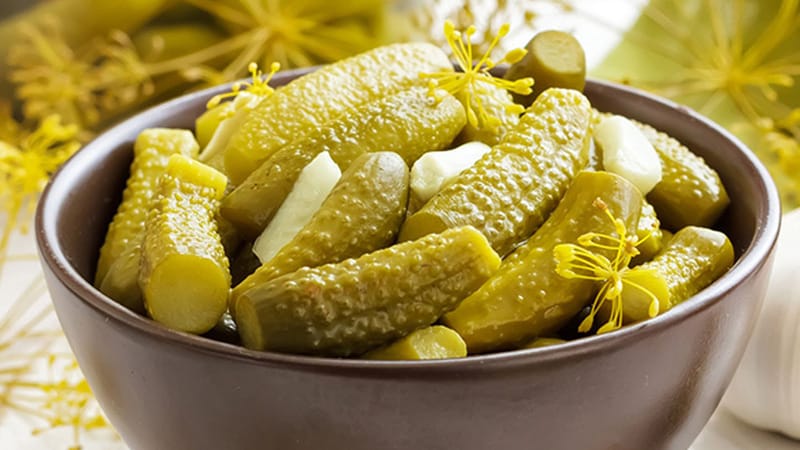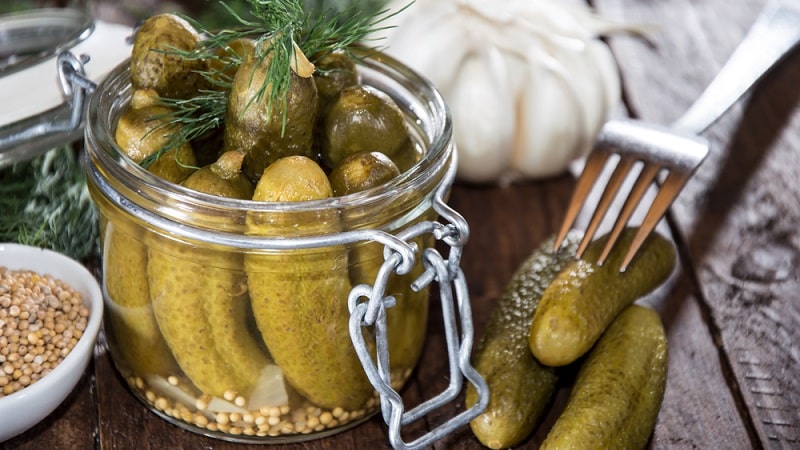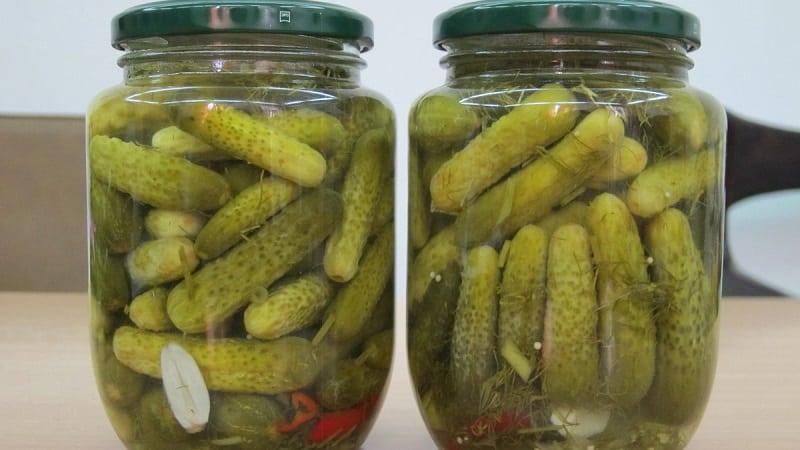Making crispy preparations for the winter: how to pickle cucumbers correctly, the best recipes
Experienced summer residents know that not all varieties of cucumbers are suitable for pickling for the winter. To enjoy crispy vegetables during the cold season, it is important to choose the right fruits, add certain ingredients and ensure optimal storage conditions for the preparations. We will tell you how to do this in our article.
Which cucumbers are suitable for pickling?

Conventionally, all varieties are divided into 3 main types:
- salad;
- canning and pickling;
- universal.
Salad varieties include early varieties that are planted in greenhouses or under film. These cucumbers have juicy flesh, thin skin, but a satisfactory or good taste. The length of vegetables is up to 20 cm.
Universal varieties are more recent; they are grown in a greenhouse or open ground. These fruits grow small, up to 10 cm.
Selection and preparation of vegetables
Suitable varieties for pickling are those whose fruits are covered with thin skin, the flesh is elastic, and in the marinade it acquires a characteristic crunch and a pronounced taste. Such vegetables are usually small, up to 8 cm. The surface is covered with tubercles and black spines. If the cucumbers are white, they are not suitable for pickling: they have rough and thick peel.
For winter preparations, special varieties and hybrids are planted:
- Nezhinsky;
- F1 debut;
- Muromsky 36;
- Polina F1;
- Parker F1.
In what container to salt

For pickling Not every container is suitable. The main condition is that it should not rust or oxidize, otherwise harmful substances will get into the brine and there will be a risk of poisoning.Therefore, aluminum and galvanized containers are not used.
The safest containers:
- Plastic container. Only food grade plastic is suitable for this. Such vegetables are consumed within one month, otherwise harmful microorganisms will begin to develop in the container.
- Glass banks. The container is suitable for long-term storage of food, but vegetables in it often lose their crunch. The jars are made completely airtight by rolling them with iron lids.
- Wooden barrels. Brine infused in a wooden container and cucumbers have a rich woody taste, a strong aroma without the addition of special ingredients. Wood provides long-term storage of vegetables.
How to pickle cucumbers correctly
It is important not only to choose the right container, but also to pay close attention to the contents. The taste of the finished product and the duration of its storage will depend on this.
Ingredients
It is advisable to use spring or well water. If you can’t get it or you’re not sure of the quality, take tap water, carefully filtered and boiled.
Cucumbers freshly picked from the garden are soaked in water for 2-3 hours to make them more elastic and strong.
Depending on the recipe, the following is added to the brine:
It is better to use rock salt: it gives a rich and rich taste to vegetables. Iodized one softens vegetables.
The containers are thoroughly washed and treated with boiling water to get rid of harmful microorganisms.
Step-by-step instruction

There are 2 main ways to salt cucumbers: hot and cold. They differ fundamentally from each other in the order of actions and further storage.
Hot way:
- Salt is dissolved in boiling water, spices are added to the brine: dill and horseradish stems, oak leaves and other ingredients to taste.
- Cucumbers are placed tightly in glass containers, preferably in a vertical position.
- Everything is filled with brine. The jars are placed in a cold place for about a week.
- If necessary, add the required amount of brine, and seal the jars with iron lids.
Hot pickling can be stored for several years if the seals of the containers are not broken and the lids are not swollen.
Cold way:
- Vegetables are placed in jars or other containers immediately along with spices.
- Stir the salt in cold water and pour the solution over the vegetables.
- The containers are closed so that air does not enter.
The cucumbers will be salted in 3-4 days and will be finally ready in about a month. Before this, they are kept in a dark, cool place: a cellar or refrigerator. If left in a warm apartment, there is a risk that the cans will explode.
Advice. To put on the plastic lid, it is preheated in boiling water. The material becomes softer, and when cooled, it sits tightly on the neck of the jar.
Best Recipes
There are several universal ways to prepare cucumbers, which are suitable as an independent snack, a component for pickle sauce or salads.
Classic cucumbers with garlic

To prepare for 1 kg of vegetables take:
- dill - 1 bunch;
- garlic - 2 cloves;
- salt - 1 tbsp. l;
- water - 1 l.
Cucumbers are salted hot. Such vegetables do not have any foreign taste, so they are added to various dishes.
With mustard powder
The marinade is prepared hot in the following proportions:
- water - 1 l;
- mustard powder - 2 tbsp. l.;
- salt - 1 tbsp. l.;
- dill - 1 bunch.
Mustard will give vegetables a piquant pungency and a special taste, but if you add a lot of it, the product will become bitter.
With vodka
These cucumbers are prepared cold. At the same time, they retain their crunch and rich taste. Typically, three-liter glass jars are used, which are thoroughly washed and sterilized over steam or in the oven.
Ingredients:
- cucumbers;
- horseradish and currant leaves;
- dill umbrellas;
- garlic;
- peppercorns (white, black and allspice);
- salt - 3 tbsp. l.;
- water - 1.5 l;
- vodka - 50 ml (per three-liter jar).
Crispy cucumbers “Like barrels”

Tasty, aromatic and crispy vegetables, like grandma’s in the village, are made at home, in a jar. They will taste almost the same as in an oak barrel. They are prepared cold. Cucumbers are pre-soaked for 3-4 hours.
Ingredients:
- 5 cloves of garlic;
- 2-3 leaves of horseradish;
- sprig of dill;
- 5 leaves of cherry, grape and currant;
- 2 tbsp. l. salt.
With Aspirin
“Aspirin” is used as an artificial preservative during pickling: it prevents the development of bacteria in the jar and gives elasticity to the fruit. This recipe is suitable for hot and cold methods.
By the way. Cucumbers with Aspirin are well preserved not only in the refrigerator and basement, but also at room temperature.
Ingredients:
- 1.5 kg of cucumbers;
- 1–2 Aspirin tablets;
- 1 liter of water;
- 1 bay leaf;
- 4-5 black peppercorns;
- 10 g citric acid;
- 25 g sugar;
- 50 g salt;
- 3 cloves of garlic;
- parsley;
- dill;
- currant and cherry leaves.
How to store

The shelf life of salted vegetables directly depends on storage conditions and packaging.
Cucumbers in jars are suitable for consumption for up to six months when prepared cold, and up to several years when hot pickled.After opening the container, the seal is broken and the souring of the product accelerates. After some time, the vegetables become soft.
Cucumbers are kept in barrels for up to 2-3 months. This is due to the fact that the container is not airtight, fermentation occurs quickly in such conditions - vegetables become covered with unpleasant mucus, their taste deteriorates, and a pungent odor appears. To slow down this process, pickles are left in a cold place (temperature no higher than 0...+1°C).
Frozen cucumbers are kept without brine, in a sealed plastic bag where air does not enter. The maximum shelf life is 5-6 months. But when frozen, vegetables lose their elasticity and crunch.
What mistakes to avoid
To make cucumbers tasty, crispy and stored for a long time, follow several rules:
- do not use yellowed and wilted fruits;
- do not add too many spices;
- Before cooking, everything is thoroughly washed, the container is treated with boiling water or steam;
- For better storage, the tails of the cucumbers are cut off.
Mold and plaque, which often arise when storing vegetables in wooden barrels and using a cold cooking method, are promptly removed from pickles.
Conclusion
To ensure that pickled cucumbers are stored for a long time and do not lose their taste, vegetables are selected without defects, the containers are thoroughly washed and sterilized, and filtered and boiled water is used. Fermentation in the product accelerates at high temperatures, so the preparations are kept in a cool, dark place, with a temperature of -1...+4°C, air humidity 85–95%.